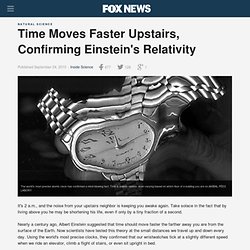

Time Moves Faster Upstairs, Confirming Einstein's Relativity. The world's most precise atomic clock has confirmed a mind-blowing fact: Time is indeed relative, even varying based on which floor of a building you are on.Aníbal Pées Labory It's 2 a.m., and the noise from your upstairs neighbor is keeping you awake again.

Take solace in the fact that by living above you he may be shortening his life, even if only by a tiny fraction of a second. Nearly a century ago, Albert Einstein suggested that time should move faster the farther away you are from the surface of the Earth. Now scientists have tested this theory at the small distances we travel up and down every day. Time dilation. Time dilation explains why two working clocks will report different times after different accelerations.

For example, ISS astronauts return from missions having aged slightly less than they would have been if they had remained on Earth, and GPS satellites work because they adjust for similar bending of spacetime to coordinate with systems on Earth.[1] An accurate clock at rest with respect to one observer may be measured to tick at a different rate when compared to a second observer's own equally accurate clocks.
This effect arises neither from technical aspects of the clocks nor from the fact that signals need time to propagate, but from the nature of spacetime itself. Overview[edit] In theory, and to make a clearer example, time dilation could affect planned meetings for astronauts with advanced technologies and greater travel speeds. AMN-chapter.dvi - Logicofspacetime.pdf. Time standard. Standardized time measurements are made using a clock to count periods of some cyclic change, which may be either the changes of a natural phenomenon or of an artificial machine.

Historically, time standards were often based on the Earth's rotational period. From the late 17th century to the 19th century it was assumed that the Earth's daily rotational rate was constant.[1] Astronomical observations of several kinds, including eclipse records, studied in the 19th century, raised suspicions that the rate at which Earth rotates is gradually slowing and also shows small-scale irregularities, and this was confirmed in the early twentieth century.[2] Time standards based on Earth rotation were replaced (or initially supplemented) for astronomical use from 1952 onwards by an ephemeris time standard based on the Earth's orbital period and in practice on the motion of the Moon.
Various types of second and day are used as the basic time interval for most time scales. Other time scales[edit]